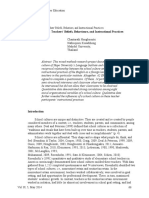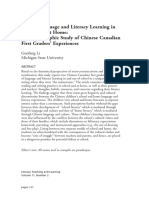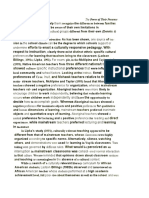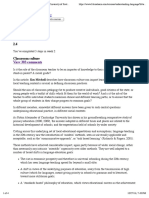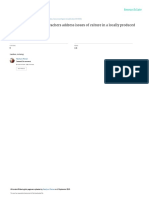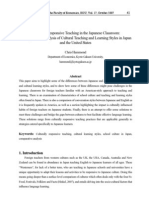Je LT 620305
Je LT 620305
Uploaded by
motivatedblinkCopyright:
Available Formats
Je LT 620305
Je LT 620305
Uploaded by
motivatedblinkOriginal Title
Copyright
Available Formats
Share this document
Did you find this document useful?
Is this content inappropriate?
Copyright:
Available Formats
Je LT 620305
Je LT 620305
Uploaded by
motivatedblinkCopyright:
Available Formats
The Impact of Personal Identities of Teachers on their Teaching
Practice: An Exploratory Study
P Ravi Kumar
ABSTRACT
This research paper explores the impact of personal identities of teachers on their teaching
practice. The construct of personal identity plays a significant role in the professional
life of a teacher. Research in teacher identity becomes more relevant as teachers encounter
multicultural and multilingual students in diverse classrooms. Research has placed a
special focus on the personal, social, economic, cultural, educational, and institutional
factors, which shape teachers’ personal identity. Personal identities of teachers are
constructed by gender, sexuality, region, religion, nationality, ethnicity, and culture in a
society. Teachers’ current teaching is greatly affected by the background and the personal
identities that the teachers carry with them to the classroom. Hence, the study also explores
whether the teachers are aware of the impact of teacher personal identities on teaching
practice. The participants were from government schools. The data were collected through
questionnaire and classroom observation. The study hypothesized that language teachers
possess multiple personal (gender, religion, region, class, etc.) identities and these affect
teaching practice. The findings of the study reveal that teachers are aware of the personal
identities that they possess. The study suggests that awareness of the formation of teacher’s
personal identity helps teachers understand who they are as individuals, teachers, and
members of the teaching fraternity.
Keywords: Teacher identity; personal identities; teaching practice.
Introduction language teaching is played out. There are
many aspects of identity like gender, class,
Language teacher identity is an emerging area and caste. The teacher is not a neutral player
of interest in research in language teacher in the classroom. A teacher’s position in
education and teacher development. There relation to his/her students and the context
has been a significant contribution by applied in which they are situated is vital. Current
linguistic research to this area (e.g., Duff & research on teacher personal identity
Uchida, 1997; Johnson, 1999, 2003; Morgan, highlights the fact that language teaching in
2004; Pavlenko, 2003; Varghese, 2000). classrooms cannot be separated from the
Teachers play a role in classroom practices; teachers’ background. Teacher personal
hence, the teacher becomes the focus of identity includes teachers’ personal lives,
research. Language teachers’ identity is seen beliefs and values, teachers’ networks,
as a crucial component in determining how teachers’ interactions, teachers being
20 Journal of English Language Teaching, Vol. 62, No. 3, May-June 2020
teachers, and so on. Teachers are individuals multiple. These multiple identities affect
with a multiplicity of selves inside a socio- classroom practices. The present research
cultural and institutional context. They attempts to explore this issue.
interact with students and staff who come
from multilingual and multicultural Review of literature
backgrounds. Therefore, teachers’ own A number of researchers have examined how
identity plays a vital role in the classroom. a teacher’s experiences of identity – gender,
Teachers reflect on their own multiplicity of race, class, culture, or sexual orientation, for
identity as they grow professionally. example – both shape and are shaped by the
Background to the study process of instruction and interaction that
evolves within specific sites of bilingual and
As teachers possess multiple identities and second/foreign language education.
play different roles and as students also come
from multilingual and multicultural Norton (1997) illustrates the significant
backgrounds, there is always the problem of relationship among identity, language
bridging these identities and roles. There is a learning, and classroom teaching. Norton
constant interaction between teachers (with uses the term ‘identity’ to refer to how people
multiple identities) and students (with understand their relationship to the world,
multiple socio-cultural backgrounds) in the how that relationship is constructed across
multidimensional setting of the classroom. time and space, and how people understand
These interactions form teachers’ identities. the possibilities for the future. Norton
Teachers are not always consciously aware presents the story of Mai, a young woman
of the existence of multiple identities. These from Vietnam, taking ESL courses at night
identities can affect the teaching-learning in order to improve her spoken and written
process consciously or unconsciously. For English. The study has found that the
example, a teacher might carry over a relationship between language and identity
disturbed moment from home to the is not only abstract and theoretical but also
classroom, which will negatively affect his/ has important consequences for positive and
her classroom on a given day. A teacher’s productive language learning and teaching.
personal life becomes part of his/her personal In the study of Norton, Mai’s teacher
identity. Thus, there is greater need for attempted to incorporate the lived histories
teachers to be conscious of such subtle of the students into the classroom by inviting
influences in their professional life. Teachers them to share their heritage with the rest of
as individuals and as social beings play their the class, but this approach did not have the
roles in institutional settings (the students, desired pedagogical effect, at least on Mai.
the curriculum, the textbooks, colleagues, Duff and Uchida (1997) report a six-month
management, parents, etc.). In the process, ethnographic study of four teachers of a class
their identity as teachers gets shaped and in an adult EFL program at the Kansai Cross-
reshaped. As the roles and responsibilities of Cultural Institute (KCCI, a pseudonym), in a
teachers increase, their identities also become large Japanese coastal city. The lives of four
Journal of English Language Teaching, Vol. 62, No. 3, May-June 2020 21
EFL teachers and their students were between what the teachers believed or
examined. The study was conducted in a proclaimed about their cultural practices and
large, well-established, private educational identities, on the one hand, and what actually
institution in a medium-sized Japanese transpired in class, on the other.
coastal city. The four subjects studied were a
male American teacher, a female American The four teachers in the study pursued various
teacher, and two Japanese female teachers, connections:
all of them in their late 30s, with roughly 1.5 a) between their lives and those of their
years of teaching experience at KCCI. The students;
study showed that the teachers’ perceptions b) between the classroom and the English
of their socio-cultural identities were found speaking world beyond;
to be deeply rooted in their personal histories,
c) between the textbook and the local culture;
based on past educational, professional, and
cultural experiences. They were also subject d) between institutional goals and their
to constant negotiation due to changing personal pedagogical aspirations;
contextual elements, such as the classroom/ e) between their pedagogical beliefs and their
institutional culture, instructional materials, actual teaching;
and reactions from students and colleagues. f) between past-present and present-future;
The biographical and professional basis of and
identity construction and negotiation relevant g) between their role as national (i.e., local)
in this study included past learning versus expatriate teachers, and their
experiences, past teaching experiences, and membership in the wider Japanese
cross-cultural experiences. community.
The study also argued that, in addition to Thus, the study suggests that, in teacher
teachers’ biographical and professional education programmes, student teachers and
identities, the contextual basis of teaching practising teachers should reflect on their
includes the local classroom culture, the teaching foundations and experiences,
institutional culture, and the textbook, or the cultural biases and understandings, and
curriculum. Class observations of the four knowledge of what constitutes cultural
teachers revealed their particular seating knowledge.
arrangements, use of audio-visual equipment
and materials, organization of lessons and Current research on teacher identity
activities, break-time behaviours, viewpoints highlights the fact that teacher identity cannot
on issues, and conflicts were impacted by the be separated from classroom practice. Gee
culture the teachers came from. All of the four (1996) points out that in any teacher’s
teachers had been forced by their classes to communication to their students, the what,
create an entertaining, mind-broadening, the who, the to whom, and the why all come
nurturing, exciting classroom environment. into play. Moreover, “it’s not just what you
The results indicated that in each teacher’s say or even how you say it; it’s who you are
class, contradictions sometimes arose and what you are doing while you say it.” In
22 Journal of English Language Teaching, Vol. 62, No. 3, May-June 2020
other words, the construct of teacher identity classroom interaction, and classroom
shapes and determines classroom learning. management).
Rationale for the Study Hypothesis
A number of researchers have examined how The study hypothesized that teachers possess
a teacher’s experience of identity – gender, multiple personal identities, such as caste,
race, class, culture, or sexual orientation – gender, religion, region, and class, which
both shapes and is shaped by the process of affect their teaching practice.
instruction and interaction that evolves within
specific sites of bilingual and second/foreign Research questions
language education. However, research on The study attempted to answer these research
teacher identity in the Indian context remains questions:
relatively undocumented and therefore
deserves attention. A lot of research has i) Are teachers aware of their personal
already gone into teacher cognition as a part identities?
of teachers’ professional development, but ii) How do the personal identities of teachers
the personal identity of teachers in the Indian affect their teaching practices?
context remains unexplored.
Research methodology
India is a multicultural and multilingual
country. The education system in India has The present study was an exploratory study.
to address the complexities of pluralism. A questionnaire and classroom observation
Teacher education addresses the kind of were the tools used to collect data.
problems that teachers face. As teachers come The subjects for the study consisted of six
from different social, economic, cultural, and teachers from different schools – five female
academic backgrounds, the way they teach teachers and one male teacher. They were
affects the way the students learn. Teachers intentionally chosen from different cultural,
have both personal and professional social, economic and linguistic backgrounds.
identities. What teachers know and do is part
of their identity, which is continuously The research was carried out in six different
performed and transformed through schools, located in and around the twin cities
interaction in classrooms. Hence there is a of Hyderabad and Secunderabad. These
need for the present study into the area of schools differ socially, economically,
teacher personal identity in the Indian culturally, religiously, and linguistically. The
context. multidimensionality of the schools helped the
researcher understand the impact of these on
Aim of the Study the formation of teacher identity. Teachers
The study reported here aimed to explore the working in these institutions had developed
impact of teacher personal identity (e.g., a particular identity depending on the
class, caste, region, gender, and religion) on institution they were working in. Thus, the
teaching practice (e. g., decision making, setting contributed to knowing and
Journal of English Language Teaching, Vol. 62, No. 3, May-June 2020 23
understanding the teachers’ identities better. Question:
Data Analysis and Interpretation Are you aware (possess) of your gender, social,
religious, family and professional identities?
The data collected for this study were • Give one instance of your identity as male/
responses to the questionnaire and classroom female teacher that made you
observations designed to explore personal comfortable/ uncomfortable in the class.
identity factors which affect teaching • Give one instance of how your identity
practice. (e.g., as someone belonging to a
particular community/caste) has affected
Responses to the Questionnaire and the
your interaction with particular students.
Analysis
• Give one instance of the religious identity
The participants had responded to questions that made you comfortable/uncomfortable
in the teacher identity questionnaire. in dealing with any text in the classroom.
Table 1 - Awareness of Formation of Teacher Identity
Teacher Awareness
of identity Instances of gender identity impact
formation
Teacher A Aware As a female teacher I am comfortable in the class. I can
understand the girl student problems. Once one boy in the class
X was not listening. By observing his face, I asked him what
was the problem. He said that he was hungry and did not eat
anything, so I let him go and have lunch.
Teacher B Aware As a female teacher the shades of a motherly concern and
affection can be shown to the students.
Teacher C Aware I teach in a girl’s school so I never felt uncomfortable handling
them.
Teacher D Aware Teaching in co-ed institution girls feel more comfortable with a
lady teacher; boys take some time to adjust.
Teacher E Aware When some of the X standard boys behaved in a arrogant manner,
when I shouted at them and was about to slap them.
Teacher F Aware In spite of being a class-teacher, I could not have one-to-one
response from the girl child for their uninformed absence.
From the responses (Table 1), it can be stated mother, a wife, a friend, and a colleague before
that teachers possess and are aware of personal entering the language classroom. A teacher is
identities – gender, social, religious, family – an educator, facilitator, tutor, discipline keeper,
and professional identities. It was also and culture educator after entering the
observed that a teacher is a female, a Hindu, a language classroom. Thus, it can be claimed
24 Journal of English Language Teaching, Vol. 62, No. 3, May-June 2020
that teachers possess different personal and This makes learning easier and stress-free for
professional identities. In responding to the the learners. Being a female teacher, Teacher
question of gender identity, what Teacher A A feels comfortable with girl students in class
said clearly showed that the teacher was indeed and claims that she can probably understand
aware of her identity and exploited an aspect them better. Empathy and the ability to
of her identity (gender identity) with empathy understand the students are thus the strengths
to build an environment of care and trust, of Teacher A. In her view, some girl students
which is supportive of leaning. Teacher B feel more comfortable with female teachers
echoed Teacher A’s views. From the responses, than male teachers. Though this was the
it can be noted that female teachers play the opinion or perception of this particular teacher,
role of a mother in the classroom. The teacher it may be concluded that a teacher’s gender
as a mother loves her students, understands plays an influential role in the language
their learning problems, and cares for them. classroom.
Table 2 – Instances of Effects of Community/Caste and Religious Identity
Teacher Instances of social Instances of religious
identity impact identity impact
Teacher A When I was teaching There was no instance of the religious identity that
English for Urdu made me comfortable or uncomfortable in dealing
medium class made me with any text in the classroom.
uncomfortable because it
was difficult for me to
make the students
understand the meaning
of certain words in Urdu.
Teacher B —- —-
Teacher C It does not affect us. We —-
treat all the students
equally.
Teacher D Did not affect in any way Did not come across such situation.
Teacher E —- When the children are asked to pray at the end of
the day some children don’t show any respect for
the prayer and there I may lose my head.
Teacher F Never experienced Yes, since the students from religious minority groups
are less in number in the class at certain situation
though they are familiar with the contextual
knowledge they do not volunteer to respond.
Journal of English Language Teaching, Vol. 62, No. 3, May-June 2020 25
From the responses to the questions of social Urdu. It is at times difficult for teachers to
identity (i.e., as someone belonging to a teach a text which is out of their culture and
particular community/caste) and religious language. However, this is not to be
identity, it was observed that their socio- considered a debilitating factor since most
religious background did not affect their teachers do put in the extra effort to make
teaching. Though the teachers were from even unfamiliar texts accessible to both
various socio-religious backgrounds, they themselves and their students.
interacted with students who were also
multicultural and multilingual. It can be noted The participants also responded to these
that these multiplicities and complexities of questions:
selves and classrooms did not affect their • Is identity a key influencing factor on
teaching and that they were comfortable in teachers’ sense of purpose, motivation,
their teaching and interactions with their commitment, job satisfaction, and
students. Teacher A shared her experience of effectiveness?
teaching English to Urdu medium students.
As she did not know Urdu, she could not • Do multiple identities influence teaching
translate difficult words from English to positively or negatively, and how?
Table 3 – Impact of Personal Identity on Teaching Practice
Teacher Is personal identity
an influencing factor Positive or negative impact of multiple identities
on teaching practice?
Teacher A Yes Multiple identities influence teaching positively.
Collaboration between teachers with varying
expertise might be successful.
Teacher B Definitely —-
Teacher C Yes —-
Teacher D No Teachers’ identity influences teaching positively
depending on various classroom situations.
Teacher E To some extent Both
Teacher F Yes Yes, impact of instruction works positively in
some cases.
From the responses of the teachers (Table factors such as personal experience, attitude,
3), it is evident that identity is a key knowledge, expectations, and values become
influencing factor on teachers’ sense of part of beliefs and these beliefs in turn
purpose, motivation, commitment, job become part of identity. These personal
satisfaction, and effectiveness. Personal factors give a sense of why they want to
26 Journal of English Language Teaching, Vol. 62, No. 3, May-June 2020
become language teachers and motivate them performed multiple roles and responsibilities
to be committed to their profession, which in the classroom. The observations revealed
gives them job satisfaction. Teachers believe that all the teachers have three different roles
that personal factors affect the way a teacher as part of their identity – educator, language
monitors classroom events, the degree of teacher, and culture teacher. The various roles
conscious effort involved in classroom that teachers played during the classroom
performance, the degree to which observations included: discipline keeper,
performance is guided by personal supervisor of the pupils, motivator, role
experience, the degree to which the teacher model, subject informant, leader of learning,
can predict events accurately, and the culture educator, moral teacher, facilitator,
decision about how to express oneself in the advisor, counsellor, etc. From the different
classroom activity etc. roles that the teachers play in the class, it can
be claimed that all of these roles form
From this study, it can be assumed that teachers’ personal and professional identities.
teachers’ teaching context, experience, and It was also observed that teachers were
biography are factors that might influence flexible in the classroom and they were aware
their perceptions of their professional of the complex needs of the different learners.
identity. With reference to the question of It was clear from the classroom observations
whether multiple identities influence that the teachers were conscious of
teaching positively or negatively, it can be multilingualism and multiculturalism of the
noted from the responses of Teacher A and students and the classrooms. The way the
Teacher D that they do believe that their teachers presented their personality (attitude,
identity does affect their teaching practice. behaviour, motive, etc.) gave the researcher
Indeed, their experiences of identity – gender, the impression that they loved their teaching,
region, religion class, culture, as examples – had a lot of respect for their profession, and
both shape and are shaped by the process of they were striving to be good role models to
instruction and interaction that evolve within their students.
specific multicultural and multilingual
language classrooms. Discussion of Results
Classroom observations An analysis of the data obtained shows that
language teachers’ personal identities are
The classes of the six teachers were observed. orchestrated as well as operationalised
Teachers were quite comfortable in the class through the roles and responsibilities that are
though the researcher was observing the class designated for them in any given socio-
sitting at the back of the class and making cultural and institutional context. The
note of what was happening in the classroom. hypothesis of the present study that language
It was observed that all the classrooms looked teachers possess multiple personal (gender,
traditional in terms of seating arrangement, religion, region, class, etc.) identities and that
the place of the teacher, the use of black these identities affect teaching practice has
board, the absence of modern technologies, been proved. For example, the roles they play
and so on. It was observed that the teachers – the transmission of knowledge, the
Journal of English Language Teaching, Vol. 62, No. 3, May-June 2020 27
transaction of culture, and the instructional prior-experiences, as examples) both shape
strategies and activities planned in class – all and are shaped by the process of instruction
have personal, social, cultural and and interaction that evolve within specific
institutional significance. The results of the sites of multilingual and multicultural
study show that a teacher is a subject expert language education in the Indian context.
(who imparts knowledge and guides
students) and a pedagogic expert (a leader of Conclusion
learners, friend, motivator and role model,
It is evident from the findings that the
facilitator). Teachers even play the role of a
teachers are aware of the multiple identities
loving parent. The results also indicate that
they possess. Personal and professional
personal factors such as personal experience,
factors become part of the teachers’
attitude, knowledge, expectations, and values
personality and they in turn become part of
become part of their beliefs and these beliefs
the multiple identities of the teachers. The
in turn become part of their identity. These
study proves that teachers play various roles
beliefs give teachers an insight into why they
such as educator, facilitator, prompter,
want to become language teachers. The study
participant, resource, tutor, language teacher,
indicates that teachers’ personal images affect
culture teacher, discipline keeper, supervisor
the way they take decisions in the classroom
of all the pupils, motivator, and leader of
and the way they organize student learning.
learning, etc. and responsibilities such as
The study also reveals that their prior
class teacher and staff co-ordinator. These
experiences, such as education (e.g., seeing
personal factors and professional lives shape,
another teacher as a relevant model – the
reshape, negotiate, and transform teachers’
image of oneself as learner), or family life
personal and professional identities. Five out
(e.g., being tolerant towards students – acting
of six teachers, who were female, felt that
like a mother) influence/shape teachers’
they, apart from being language instructors,
interaction with the students.
also acted as surrogate mothers at times. It
The results also reveal that teachers try to gear can be concluded from their responses that
their personal and professional selves to suit teachers play the role of educator, language
the challenges inherent in multilingual and teacher, and culture teacher. The teachers’
multicultural classrooms peopled by students experiences show that their identities seem
of mixed abilities and needs. Thus, the to be constantly and continuously constructed
classroom becomes a microcosm of a world and reconstructed throughout their lives. All
where teachers’ personal and professional the teachers believe that personality factors
identities are continuously constructed, co- such as attitude, motivation, and behaviour
constructed, and adjusted. The results of the become part of their personal identity. They
study indicate that a teacher’s experiences of observed that awareness of the formation of
personal identity (gender, region, class, teacher identity helped them to know where
culture, and educational background) and they were and how they related to the students
professional identity (teacher education and interacted with them. This awareness of
programmes, apprentice of observation, personal and professional lives is a step
28 Journal of English Language Teaching, Vol. 62, No. 3, May-June 2020
towards keeping themselves up-to-date and Education. 25 (2000-2001), pp. 99-125.
abreast with educational changes and
advances. Kristjánsson, K. (2007). Some Aristotelian
reflections on teachers’ professional identities
References and the emotional practice of teaching.
Beijaard, D., Meijer, P., & Verloop, N. (2004). McNamara, T. (1997). Theorising social
Reconsidering research on teachers’ identity: What do we mean by social identity?
professional identity. Teaching and Teacher Competing frameworks, competing
Education, 20, 107-128. discourses. TESOL Quarterly, 31 (3)
(Autumn, 1997), pp.561-567.
Blackledge, Adrian. and Pavlenko, Aneta.
(2001). Negotiations of identities in Morgan, B. (2004). Teacher identity as
multilingual contexts. The International pedagogy: Towards a field-internal
Journal of Bilingualism, 5, pp. 243-257. conceptualization in bilingual and second
language education. York University,
Chong, Sylvia., Low, Ee Ling., and Goh, Kim Toronto, Canada.
Chuan. (2011). Emerging professional
teacher identity of pre-service teachers. Norton, B. (1997). Language, identity, and
Australian Journal of Teacher Education, 36 the ownership of English. TESOL Quarterly,
(8). 31(3).
Cross, Russel. (2011). Identity and language Varghese, M., Morgan, B., Johnston, B.
teacher education: The potential for Johnson, and Kimberly, A. (2010). Theorising
sociocultural perspectives in researching language teacher identity: Three perspectives
language teacher identity. Australian and beyond. Journal of Language, Identity,
Association for Research in Education, and Education. 4(1), 21-44.
Adelaide (Nov. 2006), pp. 27-30.
Vesanto A. (2011). Professional identity of
Duff, Patricia A. and Uchida, Yuko. (1997). teachers of English. Masters Thesis,
The negotiation of teachers’ socio-cultural University of Jyvaskyla.
identities and practices in postsecondary EFL
classrooms. TESOL Quarterly, 31 (3), pp. Zembylas, M. (2010). Emotions and teacher
451-486. identity: A post-structural perspective. In
Teachers and teaching: Theory and practice.
Gee, J. P. (2001). Identity as analytic lens for Michigan, USA.
research in education. Review of Research in
Dr. P. Ravi Kumar, Assistant Professor of
English, Pendekanti Law College, Hyderabad.
Journal of English Language Teaching, Vol. 62, No. 3, May-June 2020 29
You might also like
- Professional identity curriculum and teaching Intercultural Communication an Indonesian case study (2)No ratings yetProfessional identity curriculum and teaching Intercultural Communication an Indonesian case study (2)19 pages
- Collaborative Teacher-Students Talks on the Identity of Native vsNo ratings yetCollaborative Teacher-Students Talks on the Identity of Native vs11 pages
- Article Critique #1: Preparing Preservice Teachers For A Diverse WorldNo ratings yetArticle Critique #1: Preparing Preservice Teachers For A Diverse World3 pages
- School Culture: Teachers' Beliefs, Behaviours, and Instructional PracticesNo ratings yetSchool Culture: Teachers' Beliefs, Behaviours, and Instructional Practices38 pages
- Teaching Culture in The EFL Classroom As Informed by Teachers' Approaches To Student DiversityNo ratings yetTeaching Culture in The EFL Classroom As Informed by Teachers' Approaches To Student Diversity35 pages
- Examples of Current Issues in The Multicultural ClassroomNo ratings yetExamples of Current Issues in The Multicultural Classroom5 pages
- Negotiating Diversity in English Language Teaching: A Tragedy in Four ActsNo ratings yetNegotiating Diversity in English Language Teaching: A Tragedy in Four Acts18 pages
- Expectations and Questions in Intercultural ClassroomsNo ratings yetExpectations and Questions in Intercultural Classrooms22 pages
- Interaction in Second Language ClassroomsNo ratings yetInteraction in Second Language Classrooms6 pages
- A Community of Practice in Teacher Education: Insights and PerceptionsNo ratings yetA Community of Practice in Teacher Education: Insights and Perceptions14 pages
- JEELS (Journal of English Education and Linguistics Studies), 6 (1), 25-50No ratings yetJEELS (Journal of English Education and Linguistics Studies), 6 (1), 25-502 pages
- Expanding The Language Teacher IdentityNo ratings yetExpanding The Language Teacher Identity15 pages
- M-ELE - Research Project - Dhia HasanahNo ratings yetM-ELE - Research Project - Dhia Hasanah18 pages
- Article Revised As Per Guideline of Publishers0% (1)Article Revised As Per Guideline of Publishers25 pages
- Teacher Identity and Agency in Language Teaching ANo ratings yetTeacher Identity and Agency in Language Teaching A21 pages
- Pre-Service Teachers' Perception of Teaching Future EFL Students: A Micro-Ethnography ApproachNo ratings yetPre-Service Teachers' Perception of Teaching Future EFL Students: A Micro-Ethnography Approach6 pages
- Please Mind The Culture Gap: Intercultural Development During A Teacher Education Study Abroad ProgramNo ratings yetPlease Mind The Culture Gap: Intercultural Development During A Teacher Education Study Abroad Program13 pages
- 1825-Article Text-7239-1-10-20110127 PDFNo ratings yet1825-Article Text-7239-1-10-20110127 PDF12 pages
- An Exploration of EFL Teachers' Teaching Styles and EmotionsNo ratings yetAn Exploration of EFL Teachers' Teaching Styles and Emotions21 pages
- Teachers' Cultural, Social and EmotionalNo ratings yetTeachers' Cultural, Social and Emotional19 pages
- A2 Research On Culture-Cultural DiversityNo ratings yetA2 Research On Culture-Cultural Diversity2 pages
- influencia del maestro de ciencias en la diversidad linguisticaNo ratings yetinfluencia del maestro de ciencias en la diversidad linguistica14 pages
- Approaches in Teaching Literature in Public Secondary Schools of Southern Nueva VizcayaNo ratings yetApproaches in Teaching Literature in Public Secondary Schools of Southern Nueva Vizcaya9 pages
- Exploring Culturally Responsive Pedagogy: Teachers' Perspectives On Fostering Equitable and Inclusive ClassroomsNo ratings yetExploring Culturally Responsive Pedagogy: Teachers' Perspectives On Fostering Equitable and Inclusive Classrooms9 pages
- The Effects of an Intercultural Approach on the Students' Conceptions About Culture (1)No ratings yetThe Effects of an Intercultural Approach on the Students' Conceptions About Culture (1)100 pages
- 2classroom Culture - Understanding Language - University of SouthamptonNo ratings yet2classroom Culture - Understanding Language - University of Southampton4 pages
- Meaningful Learning in The Co-Operative ClassroomNo ratings yetMeaningful Learning in The Co-Operative Classroom20 pages
- Kiss T. and Rimbar H. 2017 Unity in DiveNo ratings yetKiss T. and Rimbar H. 2017 Unity in Dive16 pages
- Article Critique-Journal of Teacher EducationNo ratings yetArticle Critique-Journal of Teacher Education7 pages
- Short Paper 3_Veasna chann We all know that understanding a language involves not only knowledge of grammar, phonology and lexis but also a certain features and characteristics of the culture and society. Since language teaching has been influenced by society, Sociolinguistic study can provide insights related to other important aspects of the learning experiences of bilingual students, such as how language relates to their identity, affective experiences, and relationships (Gaerlan & Bernardo, n.d.). With regard to these aspects, Llamas and Stockwell (2002) claim, “teachers who are aware of the sociolinguistic context had insights at their disposal which can make them better teachers.” According to the usefulness of sociolinguistic awareness mentioned above, it is very important for teachers to explore its factors that influence on language teaching. Obviously, one of the examples of parents’ influence that teachers should be aware of is that all parents are anxious and willing tNo ratings yetShort Paper 3_Veasna chann We all know that understanding a language involves not only knowledge of grammar, phonology and lexis but also a certain features and characteristics of the culture and society. Since language teaching has been influenced by society, Sociolinguistic study can provide insights related to other important aspects of the learning experiences of bilingual students, such as how language relates to their identity, affective experiences, and relationships (Gaerlan & Bernardo, n.d.). With regard to these aspects, Llamas and Stockwell (2002) claim, “teachers who are aware of the sociolinguistic context had insights at their disposal which can make them better teachers.” According to the usefulness of sociolinguistic awareness mentioned above, it is very important for teachers to explore its factors that influence on language teaching. Obviously, one of the examples of parents’ influence that teachers should be aware of is that all parents are anxious and willing t5 pages
- Iftanti, E. (2019) - Inter and Intra-Culture-Based Group Discussion To Promote Learning Autonomy in A Bicultural ClassNo ratings yetIftanti, E. (2019) - Inter and Intra-Culture-Based Group Discussion To Promote Learning Autonomy in A Bicultural Class2 pages
- Tourism - Sustainable Tourism Study Guide For TestNo ratings yetTourism - Sustainable Tourism Study Guide For Test16 pages
- Business Plan Template For Community Internet CafesNo ratings yetBusiness Plan Template For Community Internet Cafes11 pages
- Critical Success Factors of Small and Medium-Sized Enterprises in Saudi Arabia: Insights From Sustainability PerspectiveNo ratings yetCritical Success Factors of Small and Medium-Sized Enterprises in Saudi Arabia: Insights From Sustainability Perspective12 pages
- Cele Caparo Energy LTD: (London Stock Exchange)No ratings yetCele Caparo Energy LTD: (London Stock Exchange)12 pages
- Law of Tort Page: INTRODUCTION Lecture Notes Here Are From Street On Torts, Tenth Edition 1999No ratings yetLaw of Tort Page: INTRODUCTION Lecture Notes Here Are From Street On Torts, Tenth Edition 19997 pages
- Akanksha Power and Infrastructure LTD - RHPNo ratings yetAkanksha Power and Infrastructure LTD - RHP374 pages
- Mike Davis - Berlin's Skeleton in Utah's ClosetNo ratings yetMike Davis - Berlin's Skeleton in Utah's Closet10 pages
- Website Design Client Onboarding TemplateNo ratings yetWebsite Design Client Onboarding Template14 pages
- Professional identity curriculum and teaching Intercultural Communication an Indonesian case study (2)Professional identity curriculum and teaching Intercultural Communication an Indonesian case study (2)
- Collaborative Teacher-Students Talks on the Identity of Native vsCollaborative Teacher-Students Talks on the Identity of Native vs
- Article Critique #1: Preparing Preservice Teachers For A Diverse WorldArticle Critique #1: Preparing Preservice Teachers For A Diverse World
- School Culture: Teachers' Beliefs, Behaviours, and Instructional PracticesSchool Culture: Teachers' Beliefs, Behaviours, and Instructional Practices
- Teaching Culture in The EFL Classroom As Informed by Teachers' Approaches To Student DiversityTeaching Culture in The EFL Classroom As Informed by Teachers' Approaches To Student Diversity
- Examples of Current Issues in The Multicultural ClassroomExamples of Current Issues in The Multicultural Classroom
- Negotiating Diversity in English Language Teaching: A Tragedy in Four ActsNegotiating Diversity in English Language Teaching: A Tragedy in Four Acts
- Expectations and Questions in Intercultural ClassroomsExpectations and Questions in Intercultural Classrooms
- A Community of Practice in Teacher Education: Insights and PerceptionsA Community of Practice in Teacher Education: Insights and Perceptions
- JEELS (Journal of English Education and Linguistics Studies), 6 (1), 25-50JEELS (Journal of English Education and Linguistics Studies), 6 (1), 25-50
- Teacher Identity and Agency in Language Teaching ATeacher Identity and Agency in Language Teaching A
- Pre-Service Teachers' Perception of Teaching Future EFL Students: A Micro-Ethnography ApproachPre-Service Teachers' Perception of Teaching Future EFL Students: A Micro-Ethnography Approach
- Please Mind The Culture Gap: Intercultural Development During A Teacher Education Study Abroad ProgramPlease Mind The Culture Gap: Intercultural Development During A Teacher Education Study Abroad Program
- An Exploration of EFL Teachers' Teaching Styles and EmotionsAn Exploration of EFL Teachers' Teaching Styles and Emotions
- influencia del maestro de ciencias en la diversidad linguisticainfluencia del maestro de ciencias en la diversidad linguistica
- Approaches in Teaching Literature in Public Secondary Schools of Southern Nueva VizcayaApproaches in Teaching Literature in Public Secondary Schools of Southern Nueva Vizcaya
- Exploring Culturally Responsive Pedagogy: Teachers' Perspectives On Fostering Equitable and Inclusive ClassroomsExploring Culturally Responsive Pedagogy: Teachers' Perspectives On Fostering Equitable and Inclusive Classrooms
- The Effects of an Intercultural Approach on the Students' Conceptions About Culture (1)The Effects of an Intercultural Approach on the Students' Conceptions About Culture (1)
- 2classroom Culture - Understanding Language - University of Southampton2classroom Culture - Understanding Language - University of Southampton
- Short Paper 3_Veasna chann We all know that understanding a language involves not only knowledge of grammar, phonology and lexis but also a certain features and characteristics of the culture and society. Since language teaching has been influenced by society, Sociolinguistic study can provide insights related to other important aspects of the learning experiences of bilingual students, such as how language relates to their identity, affective experiences, and relationships (Gaerlan & Bernardo, n.d.). With regard to these aspects, Llamas and Stockwell (2002) claim, “teachers who are aware of the sociolinguistic context had insights at their disposal which can make them better teachers.” According to the usefulness of sociolinguistic awareness mentioned above, it is very important for teachers to explore its factors that influence on language teaching. Obviously, one of the examples of parents’ influence that teachers should be aware of is that all parents are anxious and willing tShort Paper 3_Veasna chann We all know that understanding a language involves not only knowledge of grammar, phonology and lexis but also a certain features and characteristics of the culture and society. Since language teaching has been influenced by society, Sociolinguistic study can provide insights related to other important aspects of the learning experiences of bilingual students, such as how language relates to their identity, affective experiences, and relationships (Gaerlan & Bernardo, n.d.). With regard to these aspects, Llamas and Stockwell (2002) claim, “teachers who are aware of the sociolinguistic context had insights at their disposal which can make them better teachers.” According to the usefulness of sociolinguistic awareness mentioned above, it is very important for teachers to explore its factors that influence on language teaching. Obviously, one of the examples of parents’ influence that teachers should be aware of is that all parents are anxious and willing t
- Iftanti, E. (2019) - Inter and Intra-Culture-Based Group Discussion To Promote Learning Autonomy in A Bicultural ClassIftanti, E. (2019) - Inter and Intra-Culture-Based Group Discussion To Promote Learning Autonomy in A Bicultural Class
- Culture Speaks: Cultural Relationships and Classroom LearningFrom EverandCulture Speaks: Cultural Relationships and Classroom Learning
- Tourism - Sustainable Tourism Study Guide For TestTourism - Sustainable Tourism Study Guide For Test
- Business Plan Template For Community Internet CafesBusiness Plan Template For Community Internet Cafes
- Critical Success Factors of Small and Medium-Sized Enterprises in Saudi Arabia: Insights From Sustainability PerspectiveCritical Success Factors of Small and Medium-Sized Enterprises in Saudi Arabia: Insights From Sustainability Perspective
- Law of Tort Page: INTRODUCTION Lecture Notes Here Are From Street On Torts, Tenth Edition 1999Law of Tort Page: INTRODUCTION Lecture Notes Here Are From Street On Torts, Tenth Edition 1999







